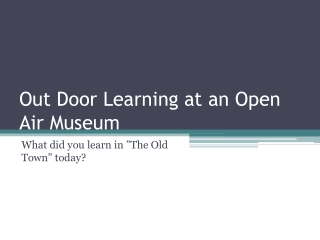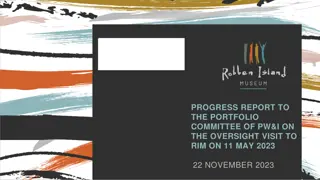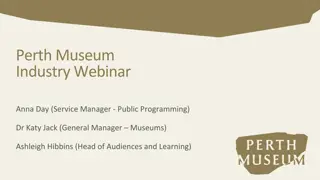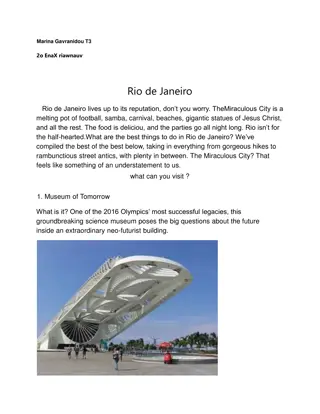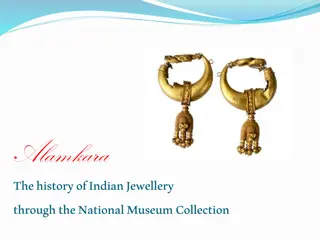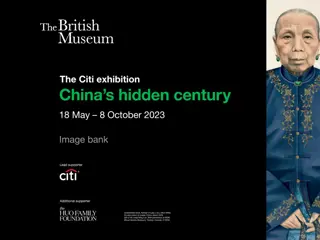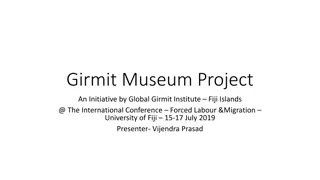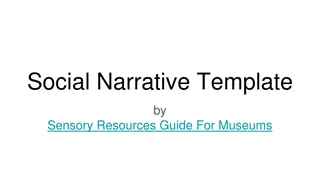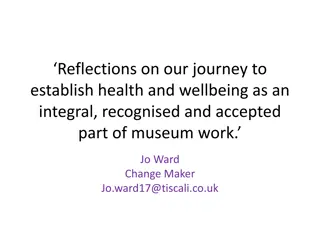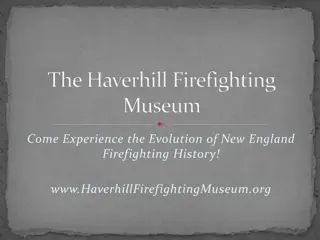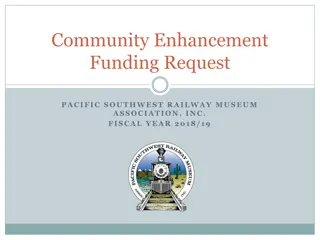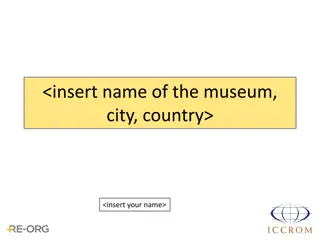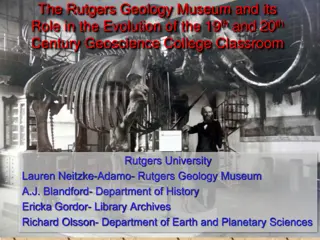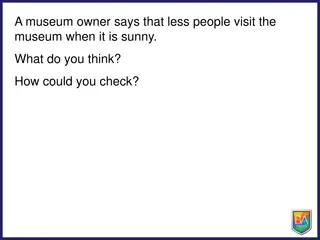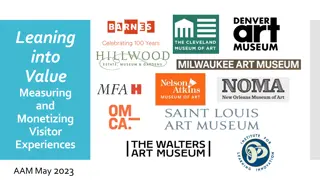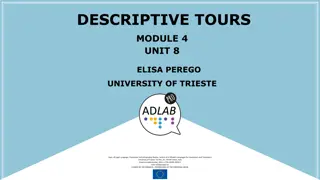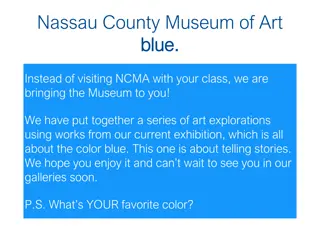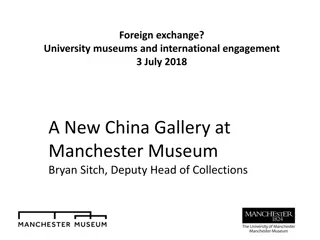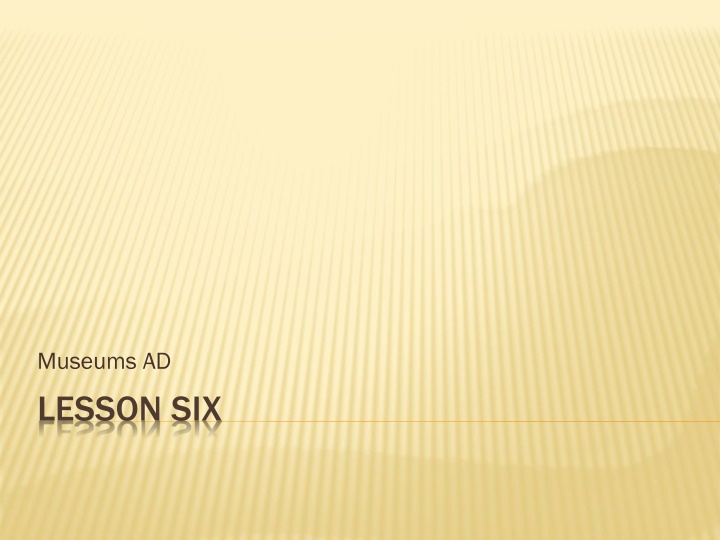
Audio Description in Museums: Enhancing Accessibility Through Verbal Descriptions
Explore the intersection of audio description (AD) and museums, focusing on making visual elements accessible to the blind and sight-impaired community. Learn about intersemiotic and intermodal translation, linguistic features of AD, its genre classification, and the language used in AD. Discover how AD is applied on screen, emphasizing its relevance to Systemic Functional Linguistics (SFL) and considerations of cohesion, coherence, and neutrality.
Download Presentation

Please find below an Image/Link to download the presentation.
The content on the website is provided AS IS for your information and personal use only. It may not be sold, licensed, or shared on other websites without obtaining consent from the author. If you encounter any issues during the download, it is possible that the publisher has removed the file from their server.
You are allowed to download the files provided on this website for personal or commercial use, subject to the condition that they are used lawfully. All files are the property of their respective owners.
The content on the website is provided AS IS for your information and personal use only. It may not be sold, licensed, or shared on other websites without obtaining consent from the author.
E N D
Presentation Transcript
Museums AD LESSON SIX
AUDIO DESCRIPTION AND MUSEUMS AUDIO DESCRIPTION AND MUSEUMS At a number of ESFLC events I have spoken about Audio Description (AD) as the description of the visual elements of a film or television product inserted in the gaps available in the dialogue principally for the benefit of the blind and sight- impaired community. the visual made verbal
INTERSEMIOTIC, INTERMODAL TRANSLATION Intersemiotic modes of meaning (images, movement, gesture, etc.); Inter-modal - from one sense to another; Interlingual translation eg. English AD to German AD
AD AS A GENRE A number of specific features of the audio description (AD) process have already been posited as justification for the labelling of AD as a genre in its own right (Taylor, 2015).
LINGUISTIC FEATURES OF AD Exclusive use of present tenses Exclusive use of third person Simple sentences Lack of subordination Parataxis Vivid vocabulary Concision Limited use of appraisal More than usual use of non-finite phrases in theme position Use of isolated noun phrases
THE LANGUAGE OF AD (CONT.) It tells a story; It has a descriptive charge (objects, colours, shapes, gestures). Iconic information in words; Objective/denotative; Correspondence between language and image; High lexical density; Wording should be appropriate to the public (scientific versus artistic language)
AD ON SCREEN These features, and their relevance to SFL, have been identified particularly in the audio description of films and television programmes (Maszerowska, Matamala and Orero, 2014) where the focus was on linguistic and pragmatic perspectives, questions of cohesion and coherence, and intertextuality. parameters of the objective/subjective spectrum cf. interpreter s neutrality source of fierce debate on appraisal
IN THE WAKE OF OTOOLE, KRESS, VAN LEUWEN Current research related to this paper has extended the study of the AD genre to museums and art galleries, thus wedding AD to the early multimodal work of O Toole, Kress and van Leeuwen, etc. Visual output has clearly become the priority (Kress)
THE STORY SO FAR The limited amount of work conducted so far on the audio description of art and the three- dimensional world of museums show first of all how the old formulae of traditional museum presentations have mutated as such institutions become more hands-on , and how audio description has produced further manipulation of the texts associated with presentation.
GOVERNMENT POLICY European Strategy on Disability 2010-2020 designed to improve social inclusion and the exercise of human rights at national and European level Cf. Americans with Disabilities Act cultural inclusion
MUSEUM From Greek museion a place sacred to the daughters of Zeus and Mnemosine 16 century a more modern sense 19 century specialisation a product of Renaissance humanism, 18 century enlightenment and 19 century democracy (Mordaunt Crook)
THE CONTEMPORARY MUSEUM Communication with the public an exposition illustrating not only the artefacts it contains but rather a series of ideas, situations, relations, questions and solved and unsplved problems . Part of an inexorable rise in hybridity and complexity.
HYBRIDITY Store of artefacts and collections Site for tourism Place of research Place of entertainment Place of education (edutainment) Place of promotion Place of merchandising Place of SERVICE access for disabled
COMPLEXITY Artefacts illustrative cards to guidebooks to audioguides to guided tours 3D productions Technological advance Lighting effects Special effects (eg Tate Modern) Educational programmes/lectures/courses Club activities Publications Access - Audio Description/touch tours/multisensory approach
LEISURE VENUES People have working models of what the museum experience affords. These affordances match public expectations and needs. Social aggregation, civil awareness, interaction
MUSEUM DISCOURSE Museum discourse is under-researched, notably in terms of its dynamic meaning production. where verbal and visual language are on display constructing specific socio-cultural mind frames and construing community involvement.
THE LANGUAGE OF MUSEUMS Construction of a narrative Cultural model of commmunication The visitor plays an active part in the construction of meaning A reconceptualisation of the relation between museums and the public (adults, children, students, families, elderly, residents, members, tourists, foreigners, handicapped)
CAPTIONING Traditional captions (often classical terminology, technical language, etc.) able to put off any visitor (Broccoli, 2010) New modes differentiated for type of visitor in terms of knowledge, status, identity. Wedded to technology audioguides, smartphones, audioguides with AD (and gps?)
THE BRITISH Audioguide for sighted Audioguide for blind and sight impaired (also available online) 20 artefacts introductions to rooms male and female voices 2-3 minute descriptions NO directions and need to see EYE
WHATS THE DIFFERENCE BETWEEN AN AUDIO GUIDE WHAT S THE DIFFERENCE BETWEEN AN AUDIO GUIDE AND AN AUDIO DESCRIPTIVE GUIDE? AND AN AUDIO DESCRIPTIVE GUIDE? A standard audio guide combines contextual and curatorial information about exhibits for the benefit of sighted visitors, but it rarely includes the necessary degree of descriptive detail descriptive detail that blind and partially sighted and partially sighted visitors require. An audio descriptive guide begins with basic information, such as the size of an exhibit, the materials it is made from, how it is labelled and displayed, before going to provide a vivid verbal picture of the exhibit itself. blind
AUDIO DESCRIPTION PROJECT Audio description at a museum, park, or exhibit is not the same as an audio tour or a docent-lead tour. Audio description has a different focus: describing the actual object, rather than addressing its creator or history, for example. A true audio description tour of a museum would actually assist in leading you from exhibit to exhibit, and the emphasis would be on size, shape, color, texture, detail. If you are lucky, you will be allowed to touch some of the objects on display, but you should not expect this accommodation.
AN AUDIO DESCRIPTIVE GUIDE MAY ALSO INCLUDE AN AUDIO DESCRIPTIVE GUIDE MAY ALSO INCLUDE DIRECTIONS TO HELP BLIND AND PARTIALLY SIGHTED DIRECTIONS TO HELP BLIND AND PARTIALLY SIGHTED VISITORS NAVIGATE FROM ONE PART OF THE GALLERY TO VISITORS NAVIGATE FROM ONE PART OF THE GALLERY TO THE NEXT: THE NEXT: If you re ready, make your way to the first display case, directly ahead of you. It straddles an ornate ironwork vent that s set into the floor and runs the length of the exhibition space. Please take care as you cross it.
HERES AN EXAMPLE FROM AN EXHIBITION AT COLCHESTER MUSEUM. HERE S AN EXAMPLE FROM AN EXHIBITION AT COLCHESTER MUSEUM. All the figures in this Exhibition date from the first part of the Han Dynasty, known as the Western Han Dynasty, from 206BC to 8AD a period when human sacrifice almost disappeared and instead various lifelike figures, made of wood or terracotta, were placed in the tombs.
AND IT PUTS INDIVIDUAL EXHIBITS IN CONTEXT: AND IT PUTS INDIVIDUAL EXHIBITS IN CONTEXT: After the formal poses of the figures we ve met so far, the ones in this case are strikingly different. Music and dance had an important role in Chinese ritual. Here 3 dancers are accompanied by 4 musicians kneeling in a row behind them. All the figures are female.
TEXTUALITY OF EXHIBITS General presentation Importance Dimensions Origins Dates State of consrvation Materials Light effect Shape Colour Decoration Anecdote Practical information
LANGUAGE OF DESCRIPTIONS Parataxis Longer sentences Simple present (continuous for actions) Modals It may be it is said to have Lexis expressive, accurate, precise. Numerous adjectives and pre-modifiers Static verbs be, stand, represent, show Art history terminology frieze, reliefs, peplo But beware of wpm!
EXAMPLE RAMESES II Ramesses II succeeded his father Sety I as ruler of Egypt in around 1279 BC and ruled for 67 years. This bust of Ramesses is from the Ramesseum, his mortuary temple at Thebes in Egypt, and dates from the 19th Dynasty, about 1250 BC. It is one of the largest pieces of Egyptian sculpture in the British Museum. It weighs 7.25 tons and measures just over two and a half metres from the top of his headdress to the base of his ribs and just over 2 metres across his shoulders.
This mammoth fragment is the upper part of a seated statue which was located in the second court of the temple. It is cut from a block of two-coloured granite - dark grey and rose pink. The bust shows an idealised image of Ramesses as a young man, with high cheek- bones and smooth skin.
Ramesses also wears the nemes or royal head- dress. The stone head-dress of the statue is surmounted by a diadem or headband in the shape of auraeus - a rearing cobra. And on top of his head Ramesses wears a modius crown encircled with cobra heads set side by side, each surmounted by a sun-disc.
in his bare torso there is a hole - approximately 5 centimetres in diameter - bored out of the granite just above his right breast. This hole is said to have been made by members of Napoleon's expedition to Egypt at the end of the eighteenth century, in an unsuccessful attempt to remove the statue. The statue was eventually retrieved from the Ramesseum by Giovanni Belzoni in 1816.
TEXTUALITY OF EXHIBITS: RAMESES II General presentation Importance Dimensions Origins Dates State of conservation Materials Light effect Shape Colour Decoration Anecdote Practical information
LANGUAGE OF DESCRIPTIONS: RAMESES II Parataxis Longer sentences Simple present (continuous for actions) Modals It may be it is said to have Lexis expressive, accurate, precise. Numerous adjectives and pre-modifiers Static verbs be, stand, represent, show Art history terminology frieze, reliefs, peplo But beware of wpm!
AUDIO DESCRIPTION OF BI-DIMENSIONAL ART Any time a sighted person assists a blind person in visualising pictures in an art gallery a type of audio description is taking place. But the need to convey explicit/implicit, objective/subjective messages through non-visual forms requires extensive pre-planning. Enter talk and touch
NATIONAL MUSEUM OF ETHNOLOGY, OSAKA Look at = touch widely, conscious of the direction your hands reach out . Watch = touch closely with your fingertips concentrating at one point See = keep your skin sensation sharp and feel with your whole body
VISUAL SENSE AND TACTILE SENSE English (like Japanese) has an abundant vocabulary for see but not for touch . It has been said that life depends on eyesight, but by applying the three elements of the sense of sight to the sense of touch, we can establish a method of approach to tactile culture. (Hirose, 2016)
THE GOLDFINCH it was harder to deceive the sense of touch than sight (p. 754) It is even harder to deceive the sense of touch and talk. Which brings us to
THE ANTEROS MUSEUM Multi-sensory approach: Touch and Words. The website tells us how to know how to see with the hands and touch with the eyes and how to convey the ambivalent/hidden/connotative/implicit elements to a blind audience . Rare personal treatment
ELENAS VISIT Neves (2012) describes the visit of Elena who was personally taken through Mantegna s The Lamentation over the Dead Christ . After an initial tactile exploration on her own, which elicited little understanding, Elena was guided through the touch tour. Her hands were taken and guided to explore the painting and her face lit up . But the whole thing was performed TO THE SOUND OF WORDS.
ELENA The picture only really came to life through language. Words were used in profusion: denotative: size, shape, location technical: style, perspective descriptive: colour, texture emotive: culture, stories
MULTIMODAL APPROACH This is where AD for museums differs greatly from AD for films, etc. The describer has to interpret, explicitate, be subjective. Appraisal comes to the fore. Art is creative and needs treating accordingly. The voice talent needs to use tone of voice, rhythm, etc. and may be accompanied by carefully chosen musical extracts.
LINGUISTIC COMPENSATION In the absence of sight, speech is essential to the integration of sensory input and therefore to perception. Speech is an effective replacement for directly experienced visual input. (Fryer, 2016)
PERSONAL EXPERIENCE Clara and Dwight at the British Museum.
PRESENCE AD users report a strong sense of presence , even through a single auditory channel Language can convey all necessary meaning (Milligan, 1995)
PAINTINGS Neves asks the question: Why would a blind person want to visit an art gallery? Are they interested? What do they cost? a visually impaired person hopes to leave the museum fully enriched by the experience. By using vivid description they are able to give me a greater level of access than they would to many researchers with sight (Smith, 2003) BUT Nothing about us without us

